Fuzzy Tandem Repeats Containing p53 Response Elements May Define Species-Specific p53 Target Genes
Evolutionary forces that shape regulatory networks remain poorly understood. In mammals, the Rb pathway is a classic example of species-specific gene regulation, as a germline mutation in one Rb allele promotes retinoblastoma in humans, but not in mice. Here we show that p53 transactivates the Retinoblastoma-like 2 (Rbl2) gene to produce p130 in murine, but not human, cells. We found intronic fuzzy tandem repeats containing perfect p53 response elements to be important for this regulation. We next identified two other murine genes regulated by p53 via fuzzy tandem repeats: Ncoa1 and Klhl26. The repeats are poorly conserved in evolution, and the p53-dependent regulation of the murine genes is lost in humans. Our results indicate a role for the rapid evolution of tandem repeats in shaping differences in p53 regulatory networks between mammalian species.
Published in the journal:
. PLoS Genet 8(6): e32767. doi:10.1371/journal.pgen.1002731
Category:
Research Article
doi:
https://doi.org/10.1371/journal.pgen.1002731
Summary
Evolutionary forces that shape regulatory networks remain poorly understood. In mammals, the Rb pathway is a classic example of species-specific gene regulation, as a germline mutation in one Rb allele promotes retinoblastoma in humans, but not in mice. Here we show that p53 transactivates the Retinoblastoma-like 2 (Rbl2) gene to produce p130 in murine, but not human, cells. We found intronic fuzzy tandem repeats containing perfect p53 response elements to be important for this regulation. We next identified two other murine genes regulated by p53 via fuzzy tandem repeats: Ncoa1 and Klhl26. The repeats are poorly conserved in evolution, and the p53-dependent regulation of the murine genes is lost in humans. Our results indicate a role for the rapid evolution of tandem repeats in shaping differences in p53 regulatory networks between mammalian species.
Introduction
Retinoblastoma is the most common pediatric intraocular tumor, that may arise in an unilateral or bilateral form. In human bilateral retinoblastoma, a germline mutation in one RB1 allele is typically observed, and the second allele undergoes somatic mutation, in agreement with Knudson's «two-hit hypothesis» for inherited cancer syndromes [1]. This defined RB as the prototypical tumor suppressor gene, and prompted several groups to develop Rb mutant mice. However, Rb+/− mice were not found to develop retinoblastomas, but rather pituitary and thyroid tumors [2]–[4]. Retinoblastomas were observed in mutant mice lacking both Rb and the Rb-like protein p107, or both Rb and the Rb-like protein p130 [5]–[8]. Additionnal studies suggested that Rb loss in the mouse retina does not lead to retinoblastoma due to a compensatory upregulation of p107 and a partially redundant expression of Rb and p130 [9]–[12].
Inactivation of the p53 pathway plays an important role in the development of murine and human retinoblastomas [13], [14]. We were intrigued by reports showing that p107-deficient mice with Rb deletion in the developing retina (Chx10Cre; Rblox/−; p107−/−) develop non invasive retinoblastomas with low penetrance, whereas similar mice with an additional retina-specific loss of p53 (Chx10Cre; Rblox/−; p107−/−; p53Lox/−), or with decreased p107/p130 levels (Chx10Cre; Rblox/lox; p107+/−; p130−/−), develop aggressive and invasive bilateral retinoblastomas [12], [13]. This led us to investigate whether p130 levels might be regulated by p53 in mice. Surprisingly, the results we obtained revealed common features for a subset of p53 target genes that are differentially regulated between mammalian species. We identified three genes (Rbl2/p130, Ncoa1 and Klhl26) that are regulated in murine cells via clustered p53 response elements located within imperfect tandem repeats (often called Fuzzy Tandem Repeats or FTRs). Because the DNA sequence of FTRs is poorly conserved in evolution, the p53-dependent regulation of these genes is not observed in human cells, and only partially conserved in rat cells. These results provide insights into the evolution of p53 regulatory networks, which may help to understand species-specific differences in tumorigenesis.
Results
Murine Rbl2/p130 is a p53 target gene
Consistent with the hypothesis that murine p130 could be regulated by p53, we observed an increase in p130 mRNA levels in response to doxorubicin in wild-type, but not p53−/− mouse embryonic fibroblasts (MEFs) (Figure 1A). A similar observation was obtained in vivo, in tissues from irradiated mice (Figure S1). Importantly, the stress-dependent increase in p130 mRNA levels led to an increase in p130 protein levels in WT MEFs (Figure 1B). We also found an increase in p130 mRNA levels in WT cells treated with Nutlin, the specific inhibitor of MDM2-p53 interaction [15], further suggesting that the stress-dependent induction of p130 results from an increased p53 activity (Figure 1C).
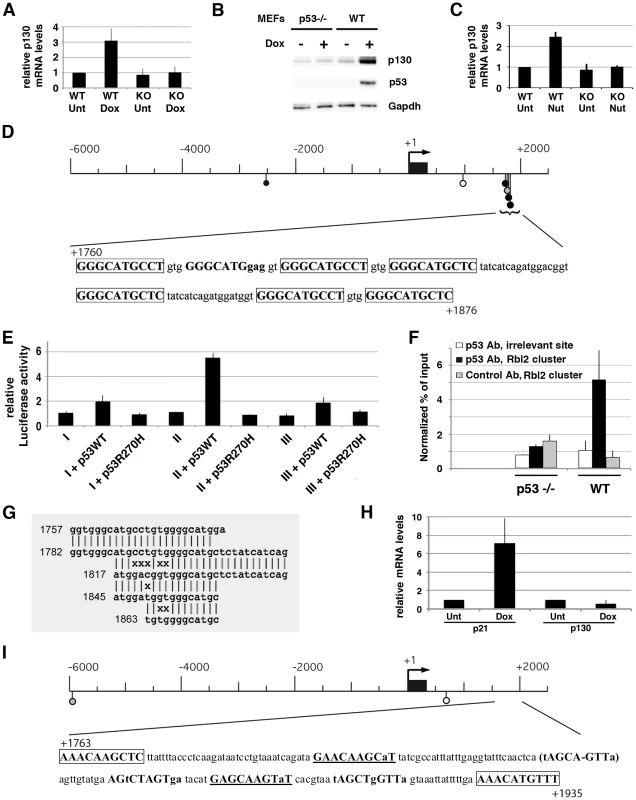
We next used an in silico approach to search for potential p53 binding sites in the murine Rbl2 gene. The consensus sequence for a p53 response element (p53 RE) was first defined as 2 copies of the 10-base pair motif RRRCWWGYYY separated by 0–13 base pairs (where R = G/A, W = A/T and Y = C/T) [16]. More recently, genome-wide ChIP-on-chip experiments allowed to further refine the consensus sequence (reviewed in [17], [18]). To perfom an unbiased search for p53 putative binding sites, we used a positional frequency matrix (PFM) recently generated by a genome-wide ChIP-on-chip experiment in human cells [19], modified to take into account varying spacer lengths (Figure S2 and Methods). An analysis of sequences from 6 kb upstream to 2.5 kb downstream of the p130 mRNA transcription start site (TSS) suggested one putative p53 RE 2.5 kb upstream of the TSS but more strikingly, a distinctive 117 bp-long cluster of putative p53 REs containing 7 p53 binding half-sites, 6 of which perfectly match the canonical RRRCWWGYYY motif (Figure 1D and Table S1). When the sequences upstream of the TSS were cloned before a luciferase reporter gene, little p53-dependent induction could be measured, whereas a strong p53-dependent induction was found for sequences downstream of the TSS, and the deletion of clustered p53 REs strongly reduced this induction (Figure 1E). In addition, the cluster of p53 REs alone, when cloned before a luciferase reporter gene, ensured a strong p53-dependent induction (Figure S3). Chromatin immunoprecipitation experiments in stressed WT and p53−/− cells then indicated significant binding of p53 to this cluster in vivo (Figure 1F). Altogether, the results show that p53 transactivates murine Rbl2/p130, and that a cluster of p53 REs in intron 1 is important for this regulation.
The p53 REs in murine Rbl2 are within fuzzy tandem repeats
The cluster of p53 REs in the murine Rbl2 gene has several unusual features: 1) a clustering of p53 binding half-sites has already been described for a few p53 target genes, but the proposed rule for such clustering is that two p53 binding half-sites match the consensus RRRCWWGYYY sequence almost perfectly, and additionnal half-sites have more degenerated sequences [20]. In the murine Rbl2 gene, 6 out of 7 p53 half-sites are perfect matches to the consensus, thus exceeding by far the proposed criteria for clustered p53 binding half-sites; 2) transactivation was shown to occur through p53 binding to repeated sequences such as retroviral elements for a fraction of p53 target genes [21], [22], or to an unusual microsatellite repeat (TGYCC)n for the target gene PIG3 [23]. A duplication most likely participated in the creation of the cluster in murine Rbl2, as evidenced by the sequence similarities between its two larger spacers (Figure 1D). However the cluster, as a whole, does not correspond to any previously described repeated sequence. To better understand the structure of the cluster, we used mreps, a software designed to detect repeats, even if they are «fuzzy», i.e. if they contain mismatches [24]. Strikingly, mreps detected fuzzy tandem repeats encompassing the entire cluster of p53 REs in murine Rbl2 (Figure 1G and Figure S4).
The p53 putative binding sites are mutated in human Rbl2
In human cells, several reports indicated that p130 is involved in the p53–p21 damage response leading to cellular senescence, but that p53 does not transactivate Rbl2/p130 [25], [26]. However, the classical assumption that important regulatory networks are evolutionnary conserved is now being challenged, particularly for trancription factors Oct4 and Nanog [27], but also for p53 [21], [22], [28]. Consistent with previous reports, we observed that, unlike the well-known p53 target Cdkn1a/p21, Rbl2/p130 is not induced in normal human fibroblasts after treatment with doxorubicin (Figure 1H) or Nutlin (not shown). The apparent difference in Rbl2 regulation between murine and human cells led us to analyze the nucleotide sequence of the human Rbl2 gene. No cluster of putative p53 RE was found in the intron 1 of human Rbl2 when using the same PFM-based criteria as for the murine locus, and most p53 putative binding half-sites were degenerated in the region homologous to the clustered p53 REs in the murine gene (Figure 1I and Table S1). Accordingly, mreps did not detect fuzzy tandem repeats in the intron 1 of human Rbl2. Thus, this intronic Rbl2 region is poorly conserved between the murine and human genomes.
BLAST with the Rbl2 p53 RE cluster reveals another murine-specific p53 target
We performed a BLAST (basic local alignment search tool) over the mouse genome with the murine Rbl2 p53 RE cluster to determine if similar cluster(s) could be involved in the regulation of other p53 target gene(s). A gene was considered a candidate p53 target if stress-induced in WT but not p53−/− MEFs (with an induction at least 2-fold in WT cells), and if containing a cluster of p53 binding half-sites less than 10 kb upstream, or less than 5 kb downstream, of the TSS. Only one candidate gene was found to fulfill these criteria: Ncoa1 (also known as SRC1), with a cluster of p53 putative half-sites 3.4 kb upstream of the TSS (Figure 2A, 2B and Figure S5). Further sequence analysis of this cluster with the p53 PFM and Consite suggested 5 candidate p53 REs (Table S2). Luciferase assays then demonstrated the importance of this cluster in the p53-dependent transactivation of Ncoa1 (Figure 2C), and ChIP showed a modest, but significant p53 binding to this cluster in vivo (Figure 2D). Like for murine Rbl2, mreps identified fuzzy tandem repeats within the murine Ncoa1 locus (Figure 2E, Figure S6), and the cluster was poorly conserved in evolution (Figure 2F). Accordingly, we did not observe a stress-dependent induction of Ncoa1 in human fibroblasts (Figure 2G). A BLAST search using the cluster of p53 half-sites at the Ncoa1 locus did not yield any additional candidate target gene.
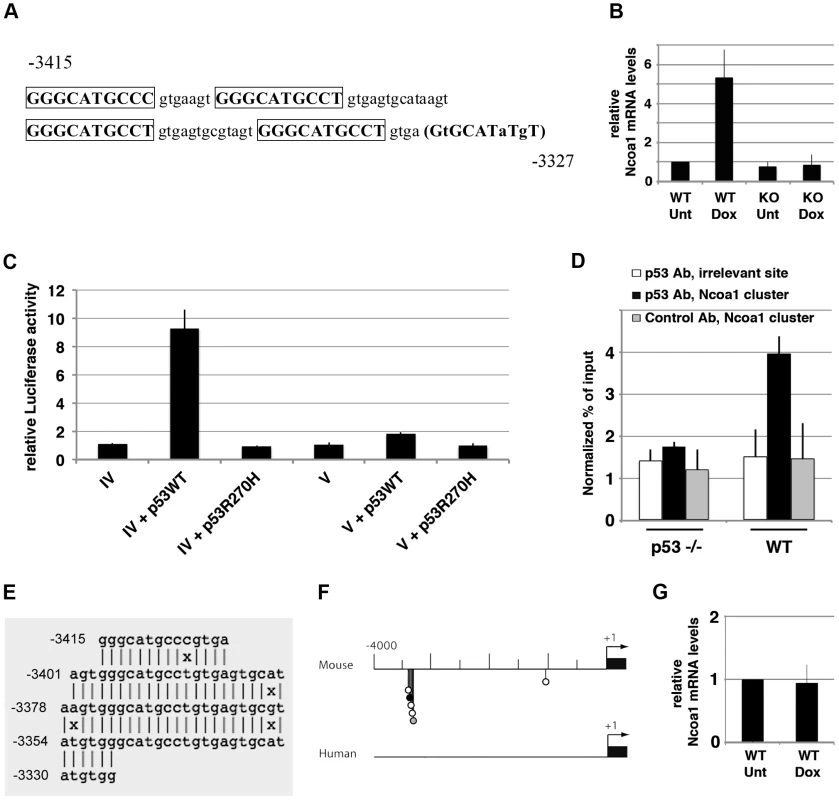
BLAST searches with synthetic clusters reveal a third gene regulated by p53 in murine but not human cells
We next decided to perform BLAST searches relying on the use of synthetic clusters of p53 REs. Each synthetic cluster was composed of 11 identical copies of a p53 RE, and each p53 RE had a sequence among the 128 most likely to be bound by p53, according to a genome-wide ChIP study [19] (Table S3). We performed 128 BLAST searches using synthetic clusters with the same criteria as before: a gene with a cluster 10 kb upstream or 5 kb downstream of its TSS, stress-induced at least 2-fold only in WT MEFs, was considered a candidate p53 transcriptional target. With this approach, an additional p53 target gene was identified: Klhl26. In a recent genome-wide ChIP-chip study, Klhl26 was listed among 573 stress-induced genes bound by p53 in murine ES cells [29]. However the study focused on genes in the Wnt signalling pathway, so that neither luciferase assays, nor quantitative RT-PCR in WT and p53−/− cells were performed to test if Klhl26 and 500+ other candidates were indeed bona fide p53 transcriptional targets [29]. Here we show that Klhl26 is a p53 target gene, and that the binding of p53 to clustered p53 REs is important for this regulation (Figure 3A–3D, Figure S5 and Table S4). Again, fuzzy tandem repeats are detected at the level of the cluster of p53 REs (Figure 3E, Figure S7), and the cluster is poorly conserved in evolution (Figure 3F–3G). BLAST searches with the cluster of p53 REs at the Klhl26 locus did not suggest additional candidate target genes.
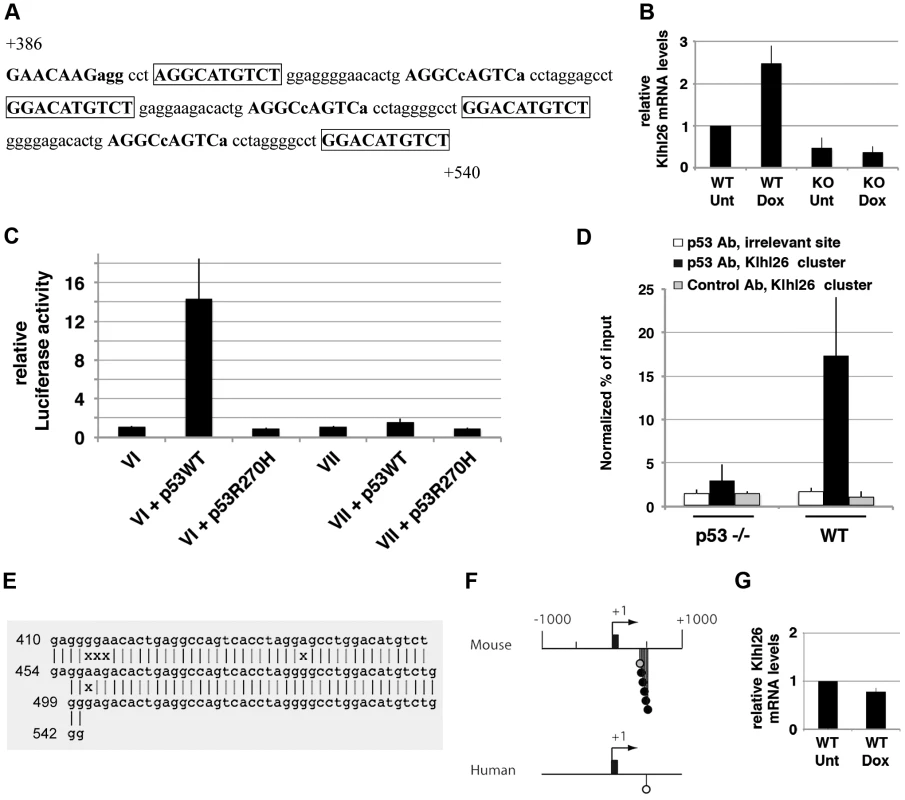
Evidence for a partial divergence in the regulation of Rbl2, Ncoa1, and Klhl26 among rodents
We identified 3 genes that are p53 transcriptional targets in murine, but not human cells. To evaluate conservation among rodents, we analyzed the promoters of these 3 genes in the rat genome. A single putative p53 RE was found at the rat Rbl2 locus at the same location as the cluster of p53 REs in the mouse gene, whereas 0 and 2 putative REs were respectively found at the rat Ncoa1 and Klhl26 loci, in the regions homologous to those containing clustered p53 REs in the murine genes (Figure 4A). These analyses indicated a significant divergence in the DNA sequence between the mouse and rat genomes at the 3 loci, with possible regulatory consequences. We next analyzed the mRNA levels for p21, p130, Ncoa1 and Klhl26 in wild-type primary rat embryonic fibroblasts (REFs), before or after treatment with doxorubicin or Nutlin. Both drugs led to strong increases in p21 and Klhl26 mRNAs, whereas p130 mRNA levels were barely increased, and Ncoa1 mRNAs were not increased at all (Figure 4B). From these results we conclude that the p53-dependent regulation of Rbl2, Ncoa1 and Klhl26 observed in murine cells is, at best, only partially conserved in rat cells.
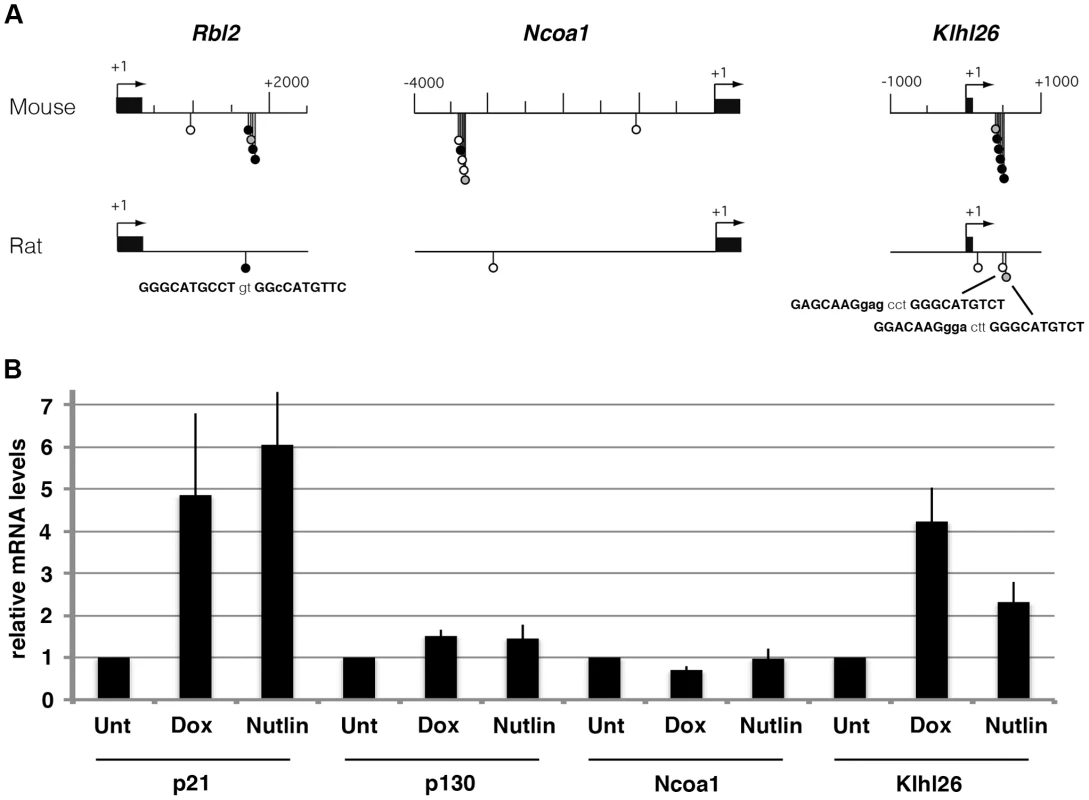
Sequences containing clustered p53 half-sites diverge rapidly
We performed a Consite analysis of the first 2.5 kb of Rbl2 genomic sequences in 8 additional mammalian species (rabbit, dog, cattle, horse, elephant, Rhesus monkey, gibbon and chimp): this provided further evidence that the clustered p53 REs in murine Rbl2 are poorly conserved in evolution (Figure 5). Consistent with this, when we searched for sequences containing clustered p53 half-sites in these 8 species in addition to mouse, rat and human, we identified a partial conservation between rodent species, or among primates, but sequences were more divergent when distant species were compared (Figure S8). Likewise, the Consite analysis of genomic sequences at the Ncoa1 and Klhl26 loci in 7 mammalian species indicated a divergence in regulation among mammals (Figure 6), further supported by a search for sequences containing clustered putative p53 half-sites. At the Klhl26 locus, a partial conservation was found among rodents or among primates, with significant divergence between more distant species (Figure S9). At the Ncoa1 locus, we could not identify significant conservation even between closely related species (not shown). These results indicate that tandem repeats containing p53 response elements evolve rapidly, which may account for differences between mammalian p53 transcriptional repertoires.
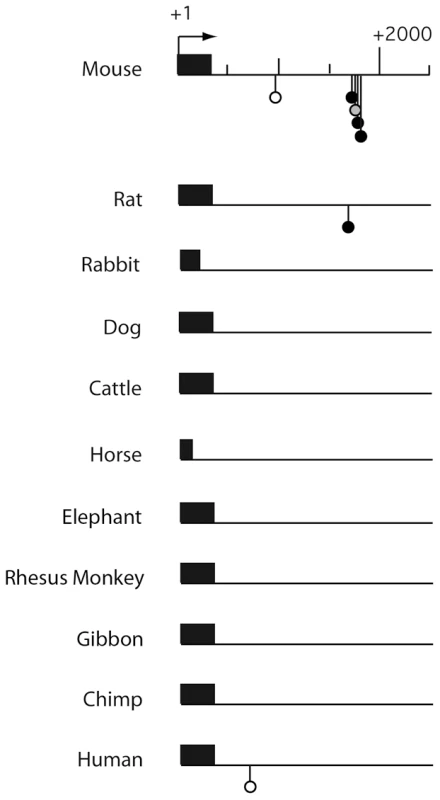
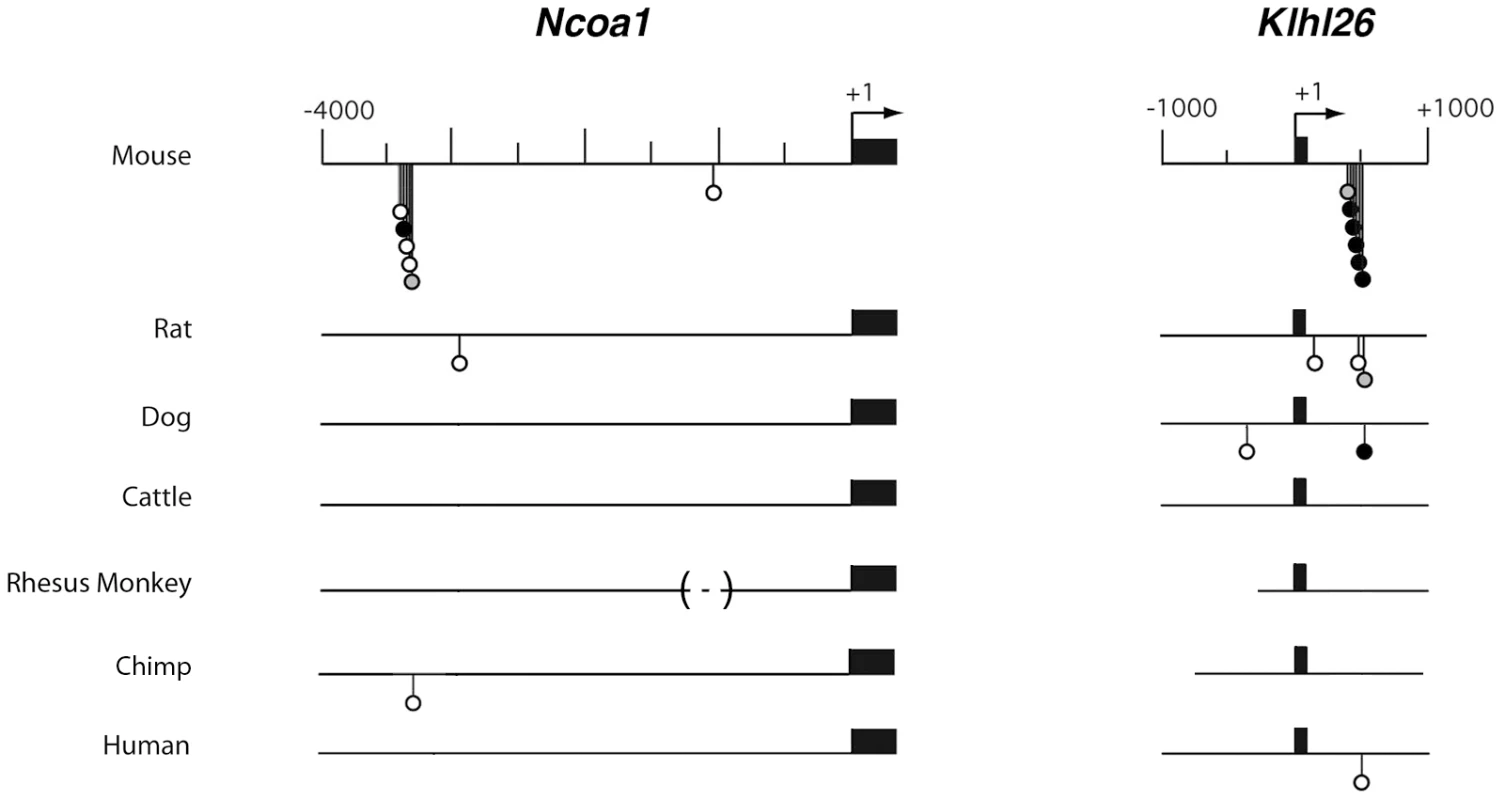
Discussion
Our analysis of species-specific gene regulation started from the observation that unlike humans, Rb+/− mice do not develop retinoblastomas [2]–[4]. Instead, retinoblastomas develop in mice with a concomitant loss of Rb and the Rb-like protein p107, or a concomitant loss of Rb and the Rb-like protein p130 [5]–[8]. Here we identified Rbl2/p130 as a p53 target gene in mouse, but not human cells (Figure 1). Thus, like Rbl1/p107 [9]–[12], Rbl2/p130 is differentially regulated in mice and humans, which may account for the different mutational events required to initiate retinoblastoma in these species. Indeed, our findings may explain why aggressive bilateral retinoblastomas develop after a retina-specific deletion of Rb in mice with decreased p107/p130 levels, or a retina-specific loss of both Rb and p53 in mice lacking p107, but not after a retina-specific loss of Rb in mice lacking only p107 [12], [13]. Also possibly consistent with our results, Rb loss is compensated by increased levels of both p107 and p130 in murine Ras-induced lung tumors, whereas in lung tumors initiated by a concomitant loss of Rb and p53, p107 levels are increased but p130 levels are decreased [30], [31]. Interestingly, murine lung tumors initiated by a loss of Rb and p53, and those initiated by the loss of Rb, p53 and p130, shared highly similar transcriptomes [31]. Together, these data suggest that the regulation of murine Rbl2/p130 by p53 may affect tumor initiation or progression.
We were surprised to find that the p53-dependent regulation of murine Rbl2/p130 relies on a cluster of p53 response elements within rapidly evolving Fuzzy Tandem Repeats (FTRs). This led us to identify two other murine p53 target genes regulated via FTRs containing p53 response elements: Ncoa1 and Klhl26 (Figure 2 and Figure 3). Both genes were found after BLAST searches over the mouse genome and expression assays in MEFs. It remains possible that other murine p53 targets regulated via FTRs escaped our search, because they are not expressed in MEFs and/or because BLAST was not programmed to detect FTRs. Although mreps is more capable of detecting FTRs, it detects repeats of any sequence, and thus cannot be used to search for repeats containing p53 REs over an entire genome. In fact, most programs for ab initio detection of repeats are unable to cope with a high level of sequence divergence between long (>24 nt) repeats [32]. In other words, fuzzy tandem repeats are difficult to detect over an entire genome due to their inherent fuzziness. Thus, the design of improved methods to find additional p53 targets regulated via fuzzy tandem repeats is an important goal. Interestingly, within tandem repeats, the number of clustered p53 REs with high Consite scores appears to correlate with the amount of p53 bound to the cluster, according to ChIP assays. Indeed, the cluster at the Klhl26 locus, with 5 high scoring p53 REs, is strongly bound by p53 (Table S4, Figure 3D), whereas the cluster at the Ncoa1 locus, containing only 1 high scoring p53 RE, appears weakly or transiently bound (Table S2, Figure 2D), and the cluster at Rbl2 ranges in between for both criteria (Table S1, Figure 1F). The identification of a larger number of genes regulated via p53 RE-containing FTRs would allow to test this possible correlation further.
Importantly, we found that the fuzzy tandem repeats are poorly conserved in evolution, so that the p53-dependent regulation of the 3 genes appears only partially conserved among rodents, and does not operate in humans. Two out of the 3 identified genes are known to be relevant to cancer biology: Rbl2 is frequently lost in a variety of human cancers and acts as a bona fide tumor suppressor in mouse models (e.g. [30]) and Ncoa1 belongs to a family of transcription co-activators often deregulated in human tumors [33]. Regarding Klhl26, its function is currently unknown, but it was found mutated in head and neck squamous cell or ovarian carcinomas [34], [35]. Such a poor conservation in the regulation of genes apparently directly relevant to p53 tumor suppressive functions may seem surprising. However, it is possible that partial functional redundancy, or compensatory mechanisms, buffer the phenotypic consequences of diverging p53 target gene repertoires among mammals. The evolution of microRNA regulatory networks among mammalian species might provide such buffering, as recently suggested for the microRNA miR-125b [36].
Unstable tandem repeats in promoters confer transcriptional evolvability in yeasts [37], and evidence of similar mechanisms in other organisms is accumulating [38]. Our data indicate that the rapid evolution of fuzzy tandem repeats containing p53 REs may shape differences in p53 transcriptional networks among mammals. Recently, mice “humanized” to carry a human-specific SNP in the Mdm2 promoter allowed to demonstrate its importance on tumor onset [39]. The characterization of species-specific p53 target genes might help to define which genes should have their regulatory sequences humanized, with the aim of improving mouse models. Importantly, the possible role of fuzzy tandem repeats in shaping the target gene repertoire of other mammalian transcription factors deserves further investigation.
Methods
Cells and tissue cell culture reagents
Primary mouse embryonic fibroblasts were isolated from 13.5 day embryos from p53+/− intercrosses, and cultured in a 5% CO2 and 3% O2 incubator for a maximum of 5 passages in DMEM Glutamax (Gibco), completed with 15% FBS (Biowest), 100 mM 2-mercaptoethanol (Millipore), 10 µM Non Essential Amino-Acids and Penicillin/Streptomycin (Gibco). Human fibroblasts from the lung (MRC5) or the foreskin (BJ) were purchased from the American Tissue Culture Cell Collection and cultured in a 5% CO2 and 3% O2 regulated incubator in MEM (Gibco), completed with 10% FBS, 2 mM L-Glutamine (Gibco), 1 mM Pyruvate, 10 µM Non Essential Amino-Acids and Penicillin/Streptomycin. HCA2 foreskin fibroblasts, originally prepared by O. Pereira, were grown like BJ cells. Primary rat embryonic fibroblasts, isolated from 14.5 days WT embryos, were a kind gift from O. Brison. All cells were treated with 0.5 µg/ml doxorubicin or with 10 µM Nutlin 3a for 24 h before RNA or protein extractions.
Quantitative RT–PCR
Total RNA was extracted using NucleoSpin RNA II (Macherey-Nagel) and reverse transcribed with Superscript III First-Strand Synthesis Supermix (Invitrogen). Real-time quantitative PCR was performed on an ABi Prism 7500 system using Power SYBR Green master mix (ABi). Primers for detecting cDNA sequence of mouse, human or rat p21, p130, Ncoa1, Klhl26 and controls Rplp0 and PPIA were designed with Primer3 Input (version 0.4.0). All mRNA expression levels were normalized to both Rplp0 and PPIA. Primer sequences are listed in Table S5.
Western blots
Protein detection by immunoblotting was performed using antibodies raised against p53 (CM5, Novocastra), p130 (C20, Santa-Cruz), GAPDH (mAb 374, Millipore), Ncoa1 (M-341, Santa Cruz), Klhl26 (C-14, Santa Cruz) and actin (A2066, Sigma). Chemiluminescence revelation of western blots was achieved with the SuperSignal substrates (Perbio, France).
In silico search for putative p53 response elements
We first used a positional frequency matrix (PFM) for p53 response elements [19], modified to take varying spacer lengths (0–13 bp) into account (Figure S2), with the Consite software (http://asp.ii.uib.no:8090/cgi-bin/CONSITE/consite) to calculate the average score of p53 REs from known p53 target genes [17]: a mean value (M) of 11.7 was found, with a standard deviation (SD) of 1.2. We then used the same PFM to search for putative p53 REs at the Rbl2, Ncoa1 and Klhl26 loci, and considered motifs with a CNWGNNN(0–13)NNNCNWR core sequence and a Consite score >10.5 as putative REs. Putative REs were plotted against the map as lollipops and included in Tables S1, S2, S3, S4, S5, S6, S7, S8, with greytones according to their score: white for scores between 10.5 and 12.9 (M+/−SD), black for scores >15.3 (M+3 SD), and grey for scores between 12.9 and 15.3.
In silico search for clustered p53 half-sites
Basic local alignment tool (BLAST) searches were performed using MouseBLAST (running WU-BLAST 2.0) from the Mouse Genome Informatics website (www.informatics.jax.org), with the BLASTN and Repeatmasker/rodents options. BAC clones identified as containing significant homology to clusters were then analyzed with Map Viewer from the National Center for Biotechnology Information (NCBI) website (www.ncbi.nlm.nih.gov/projects/mapview) to check if they contained genes. The DNA sequences of BACs with genes were retrieved using the NCBI clone registry and p53 half-site clusters were precisely mapped relative to genes by using Ensembl mouse gene annotations (www.ensembl.org/Mus_musculus/Info/Index).
Sequence analysis with mreps
We used mreps (http://bioinfo.lifl.fr/mreps/mreps.php) with default settings, and searched for repeats with error rates <0.2. This revealed fuzzy tandem repeats for the 3 murine clusters. When homologous human sequences were analyzed with the same criteria, mreps failed to detect fuzzy repeats.
Luciferase expression assays
To construct the p53 RE reporter plasmids, we cloned full promoters upstream of the firefly luciferase gene in a pGL3-basic vector (Promega), and partial promoter or intronic sequences upstream of a SV40-minimal promoter before the firefly luciferase gene (in a vector called below pGL3-PromMini or EmRep). Primers used to construct the reporter plasmids are listed in Table S6. For each experiment, 106 exponentially growing p53−/− cells were nucleofected (using the Lonza MEF2 nucleofector kit) by 3 µg of a p53 RE-firefly luciferase reporter plasmid; 3 µg of the same reporter plasmid and 3 µg of a WT p53 expression plasmid; or 3 µg of the same reporter plasmid and 3 µg of a p53R270H expression plasmid. For all points, data were normalized by adding 30 ng of renilla luciferase expression plasmid (pGL4.73, Promega). Nucleofected cells were allowed to grow for 24 h, then trypsinized, resuspended in 75 µl culture medium and transferred into a well of an optical 96 well plate (Nunc). The dual-glo luciferase assay system (Promega) was used according to the manufacturer's protocol to lyse the cells and read firefly and renilla luciferase signals.
Chromatin immunoprecipitation
ChIP analysis was performed essentially as described [40]. In brief, adherent p53+/+ and p53−/− MEFs were treated with doxorubicin (0.5 µg/ml) for 24 h. Cellular proteins from 108 cells were crosslinked to chromatin with 1% formaldehyde for 10 min at 25°C. p53-DNA complexes were immunoprecipitated from total extracts by using 50 µg of rabbit polyclonal p53 antibody (FL-393, Santacruz) and 500 µg of sonicated chromatin. Rabbit IgG (Abcam) was used for control precipitation. Quantitative PCR was performed on an Applied Biosystems 7500 instrument using Power SYBR Green master mix (ABi). Primer sequences are reported in Table S7.
Whole-body gamma-irradiation
Age-matched mice were irradiated at 6–8 weeks with a Cs gamma-irradiator with 2.9 Gy/min at a dose of 10 Gy. Mice were sacrificed 3 h later and organs were recovered, then total RNA was extracted using Trizol (Invitrogen) and quantified as before. Experiments were performed according to IACUC regulations.
Supporting Information
Zdroje
1. KnudsonAGJr 1985 Hereditary cancer, oncogenes, and antioncogenes. Cancer Res 45 1437 1443
2. ClarkeARMaandagERvan RoonMvan der LugtNMvan der ValkM 1992 Requirement for a functional Rb-1 gene in murine development. Nature 359 328 330
3. JacksTFazeliASchmittEMBronsonRTGoodellMA 1992 Effects of an Rb mutation in the mouse. Nature 359 295 300
4. HuNGutsmannAHerbertDCBradleyALeeWH 1994 Heterozygous Rb-1 delta 20/+mice are predisposed to tumors of the pituitary gland with a nearly complete penetrance. Oncogene 9 1021 1027
5. Robanus-MaandagEDekkerMvan der ValkMCarrozzaMLJeannyJC 1998 p107 is a suppressor of retinoblastoma development in pRb-deficient mice. Genes Dev 12 1599 1609
6. ChenDLivne-barIVanderluitJLSlackRSAgochiyaM 2004 Cell-specific effects of RB or RB/p107 loss on retinal development implicate an intrinsically death-resistant cell-of-origin in retinoblastoma. Cancer Cell 5 539 551
7. MacPhersonDSageJKimTHoDMcLaughlinME 2004 Cell type-specific effects of Rb deletion in the murine retina. Genes Dev 18 1681 1694
8. ZhangJSchweersBDyerMA 2004 The first knockout mouse model of retinoblastoma. Cell Cycle 3 952 959
9. SageJMillerALPerez-ManceraPAWysockiJMJacksT 2003 Acute mutation of retinoblastoma gene function is sufficient for cell cycle re-entry. Nature 424 223 228
10. SpencerCPajovicSDevlinHDinhQDCorsonTW 2005 Distinct patterns of expression of the RB gene family in mouse and human retina. Gene Expr Patterns 5 687 694
11. DonovanSLSchweersBMartinsRJohnsonDDyerMA 2006 Compensation by tumor suppressor genes during retinal development in mice and humans. BMC Biol 4 14
12. AjiokaIMartinsRABayazitovITDonovanSJohnsonDA 2007 Differentiated horizontal interneurons clonally expand to form metastatic retinoblastoma in mice. Cell 131 378 390
13. DyerMARodriguez-GalindoCWilsonMW 2005 Use of preclinical models to improve treatment of retinoblastoma. PLoS Med 2 e332 doi:10.1371/journal.pmed.0020332
14. LaurieNADonovanSLShihCSZhangJMillsN 2006 Inactivation of the p53 pathway in retinoblastoma. Nature 444 61 66
15. VassilevLTVuBTGravesBCarvajalDPodlaskiF 2004 In vivo activation of the p53 pathway by small-molecule antagonists of MDM2. Science 303 844 848
16. el-DeiryWSKernSEPietenpolJAKinzlerKWVogelsteinB 1992 Definition of a consensus binding site for p53. Nat Genet 1 45 49
17. RileyTSontagEChenPLevineA 2008 Transcriptional control of human p53-regulated genes. Nat Rev Mol Cell Biol 9 402 412
18. MenendezDIngaAResnickMA 2009 The expanding universe of p53 targets. Nat Rev Cancer 9 724 737
19. SmeenkLvan HeeringenSJKoeppelMvan DrielMABartelsSJ 2008 Characterization of genome-wide p53-binding sites upon stress response. Nucleic Acids Res 36 3639 3654
20. BourdonJCDeguin-ChambonVLelongJCDessenPMayP 1997 Further characterisation of the p53 responsive element–identification of new candidate genes for trans-activation by p53. Oncogene 14 85 94
21. WangTZengJLoweCBSellersRGSalamaSR 2007 Species-specific endogenous retroviruses shape the transcriptional network of the human tumor suppressor protein p53. Proc Natl Acad Sci U S A 104 18613 18618
22. BourqueGLeongBVegaVBChenXLeeYL 2008 Evolution of the mammalian transcription factor binding repertoire via transposable elements. Genome Res 18 1752 1762
23. ContenteADittmerAKochMCRothJDobbelsteinM 2002 A polymorphic microsatellite that mediates induction of PIG3 by p53. Nat Genet 30 315 320
24. KolpakovRBanaGKucherovG 2003 mreps: Efficient and flexible detection of tandem repeats in DNA. Nucleic Acids Res 31 3672 3678
25. KapicAHelmboldHReimerRKlotzscheODeppertW 2006 Cooperation between p53 and p130(Rb2) in induction of cellular senescence. Cell Death Differ 13 324 334
26. HelmboldHKommNDeppertWBohnW 2009 Rb2/p130 is the dominating pocket protein in the p53-p21 DNA damage response pathway leading to senescence. Oncogene 28 3456 3467
27. KunarsoGChiaNYJeyakaniJHwangCLuX 2010 Transposable elements have rewired the core regulatory network of human embryonic stem cells. Nat Genet 42 631 634
28. MenendezDShatzMAzzamKGarantziotisSFesslerMB 2011 The Toll-like receptor gene family is integrated into human DNA damage and p53 networks. PLoS Genet 7 e1001360 doi:10.1371/journal.pgen.1001360
29. LeeKHLiMMichalowskiAMZhangXLiaoH 2010 A genomewide study identifies the Wnt signaling pathway as a major target of p53 in murine embryonic stem cells. Proc Natl Acad Sci U S A 107 69 74
30. HoVMSchafferBEKarnezisANParkKSSageJ 2009 The retinoblastoma gene Rb and its family member p130 suppress lung adenocarcinoma induced by oncogenic K-Ras. Oncogene 28 1393 1399
31. SchafferBEParkKSYiuGConklinJFLinC 2010 Loss of p130 accelerates tumor development in a mouse model for human small-cell lung carcinoma. Cancer Res 70 3877 3883
32. PellegriniMRendaMEVecchioA 2010 TRStalker: an efficient heuristic for finding fuzzy tandem repeats. Bioinformatics 26 i358 366
33. XuJWuRCO'MalleyBW 2009 Normal and cancer-related functions of the p160 steroid receptor co-activator (SRC) family. Nat Rev Cancer 9 615 630
34. StranskyNEgloffAMTwardADKosticADCibulskisK 2011 The mutational landscape of head and neck squamous cell carcinoma. Science 333 1157 1160
35. The Cancer Genome Atlas Research Network 2011 Integrated genomic analyses of ovarian carcinoma. Nature 474 609 615
36. LeMTShyh-ChangSLingKawSChinLTehC 2011 Conserved regulation of p53 network dosage by MicroRNA-125b occurs through evolving miRNA-target gene pairs. PLoS Genet 7 e1002242 doi:10.1371/journal.pgen.1002242
37. VincesMDLegendreMCaldaraMHagiharaMVerstrepenKJ 2009 Unstable tandem repeats in promoters confer transcriptional evolvability. Science 324 1213 1216
38. GemayelRVincesMDLegendreMVerstrepenKJ 2010 Variable tandem repeats accelerate evolution of coding and regulatory sequences. Annu Rev Genet 44 445 477
39. PostSMQuintas-CardamaAPantVIwakumaTHamirA 2010 A high-frequency regulatory polymorphism in the p53 pathway accelerates tumor development. Cancer Cell 18 220 230
40. HuWFengZTereskyAKLevineAJ 2007 p53 regulates maternal reproduction through LIF. Nature 450 721 724
41. RileyTYuXSontagELevineA 2009 The p53HMM algorithm: using profile hidden markov models to detect p53-responsive genes. BMC Bioinformatics 10 111
42. JaiswalASNarayanS 2001 p53-dependent transcriptional regulation of the APC promoter in colon cancer cells treated with DNA alkylating agents. J Biol Chem 276 18193 18199
Štítky
Genetika Reprodukční medicínaČlánek vyšel v časopise
PLOS Genetics
2012 Číslo 6
- Primární hyperoxalurie – aktuální možnosti diagnostiky a léčby
- Šanci na úspěšný průběh těhotenství snižují nevhodné hladiny progesteronu vznikající při umělém oplodnění
- Transthyretinová amyloidóza z pohledu neurologa a kardiologa aneb jak se vyhnout „misdiagnostice“?
- Akutní intermitentní porfyrie
- Genetické testování v klinické praxi – nenahraditelný pomocník v prevenci, diagnostice i léčbě
Nejčtenější v tomto čísle
- Rumors of Its Disassembly Have Been Greatly Exaggerated: The Secret Life of the Synaptonemal Complex at the Centromeres
- The NSL Complex Regulates Housekeeping Genes in
- Tipping the Balance in the Powerhouse of the Cell to “Protect” Colorectal Cancer
- Interplay between Synaptonemal Complex, Homologous Recombination, and Centromeres during Mammalian Meiosis
